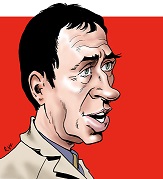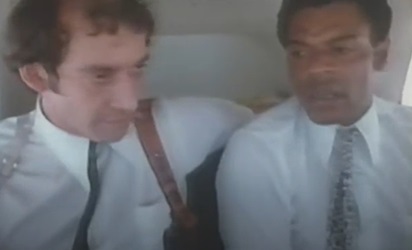
The Clones
1973

Working on a nuclear fusion project, physicist Gerry Appleby escapes from a lab accident just in time to see his car being driven off from the parking lot. Shaken and annoyed he visits his girlfriend but she is with his exact duplicate who has him arrested as an imposter. Government agents take Appleby into custody with orders to kill him, but he escapes and discovers that he has been cloned by his own employers. He uncovers a plot to control the world's weather using a network of nuclear fusion reactors controlled by 52 clones of the four crucial physicists. His own moral stance on scientific issues had made him surplus to requirements.
I recently rewatched THE CLONES, having first seen it in 1974 on the bottom-half of a double-bill with A REASON TO LIVE, A REASON TO DIE an Italian western starring James Coburn and Telly Savalas. The main feature was heavily promoted on TV to cash in on Savalas' fame as KOJAK but I've no idea why THE CLONES was attached as support. None of the actors were big names at the time and while cloning had been explored in the TV show TIMESLIP (1971) and the Jack Kirby JIMMY OLSEN comics (1970-1972) it was still a relatively obscure subject. .

Senator Tunney's 1972 Saturday Review article on cloning, quoted in the movie
According to the Moriareviews website "the phrase 'clone' had been coined by biologist J.B.S. Haldane in 1963, taken from the Greek word for twig to speculate about the idea of genetically replicating a frog. (When) applied to replicating people (the term was) popularised in the non-fiction work The Biological Time-Bomb (1968) by science journalist Gordon Rattray Taylor.".
I suspect Taylor's book opened the mini-floodgate on human cloning in pop culture. The film itself opens with a quote from the cover story of the SATURDAY REVIEW for 5 August 1972 in which Senator John Tunney warned that "asexual laboratory duplication of frogs has already been successful. The technology for the cloning of mammals will be available within five years. Unless research is stopped the technology for the cloning of human beings might be available within anything from 10 to 25 years."
I remember being dismayed at the pre-credits sequence. A black screen, held for several minutes over a soul song by the then-unknown Pattie Brooks. I don't know if that was the distributors or co-directors Lamar Card and Paul Hunt trying to pad out the running time. But it didn't bode well. The credits finally ran over footage of Gerry Appleby (Michael Greene) checking his lab equipment, as the voice of an unseen observer prepares to trigger the lab accident. It was clear this lab wasn't shot on a soundstage (credits suggest it was filmed on Los Angeles Department of Water and Power property) and this just made it seem depressingly cheap. In retrospect, the location footage shot by Orson Welles' collaborator Gary Graver is impressive, as a pre-Steadicam camera follows Greene running through yards of dimly lit service ducts to escape disaster. But back in 1974, it just looked cheap. At one point Appleby goes for help to a colleague in charge of research into cloning ( Stanley Adams, familiar to STAR TREK fans as Cyrano Jones from The Trouble With Tribbles) but ends up getting drugged. Even today you can't help feeling this is just an excuse to extend the running time with some flashbacks and psychedelic visual effects.
Having said that, viewed today THE CLONES does maintain a general level of competence. The "money shots" of Appleby with his clone twin are always clear and convincing.
Lead actor Michael Greene had been a regular in the 1963 western series The Dakotas, and had recently guest-starred in the 1973 Kung Fu episode 'Chains' as a learning-disabled character who breaks out of an army jail with David Carradine's Kwai Chang Caine. Greene's capable of carrying a better movie, but for much of its time The Clones is an extended chase.

Gregory Sierra and Otis Young as the "CID" agents hunting Appleby
One of the government agents pursuing Appleby is played by Otis Young, who had co-starred as a bounty hunter with Don Murray in the 1968 western series The Outcasts (Murray played a former Confederate officer, Young played a former slave and Union soldier). His partner, Nemo, is played by Gregory Sierra , a busy guest actor who had been one of the Mutants in Beneath The Planet of The Apes and had also appeared as Zolly, an Armenian piano player in the KUNG FU episode The Stone. You may also recall him from THE TOWERING INFERNO as the barman who tries to protect his case of vintage wine from the explosion at the end. In THE CLONES, Sierra is playing a more unsympathetic role. He briefs Young on the way to pick up Appleby telling him that Appleby is an enemy agent who has been impersonating a scientist with security clearance and that the job is a, "Code 1, that means it's a Hit! My Hit!"

Michael Greene as Dr Appleby (red shirt) and his clone.
Somehow, Appleby manages to escape and evade his pursuers. He meets up with his girlfriend Janet (Barbara Bergdorf) who says she now believes that he's the real thing. His clone has to think about how he reacts, whereas Appleby just reacts. Eventually, Appleby confronts his clone who tells him that he's also had enough of the conspiracy. He's sick of playing a prescribed role. Whether this is the sign of a distinct personality emerging, or the fact that Appleby's memories (including his principles) have been fed into the clone is never explored.
Ultimately, you get the sense that THE CLONES is a bit of a community project. Members of the crew also play small parts in the movie, while Alex Nicol (Hammer's THE HOUSE ACROSS THE LAKE, 1954) literally phones in a role as the HEW director. While Appleby is calling him a small man hammers on the door of the phone box before striding away in disgust. This is Angelo Rositto, who like Graver, co-director Paul Hunt, and Sierra would eventually appear in Orson Welles' THE OTHER SIDE OF THE WIND (posthumously released in 2018 after 48 years in production). Rositto had also recently appeared in KUNG FU as a saloon potman in the episode 'The Third Man.'
The troubled John Drew Barrymore, who gets a special billing in the credits, had played the comic book reading serial killer in While The City Sleeps (1953) and later played Dr Stephen Ward in The Christine Keeler Story (1963). Here he has a small role as a "Brooks Brothers Hippy."
Scriptwriter Steve Fisher (co-credited with the directors, suggesting off-the-cuff rewrites) had been a prolific writer for pulp magazines (including BLACK MASK) and upmarket titles such as THE SATURDAY EVENING POST. His novel I WAKE UP SCREAMING was filmed but Fisher had already began selling screenplays including LADY IN THE LAKE (Robert Montgomery, 1947) THE CITY THAT NEVER SLEEPS and 36 HOURS (Dan Duryea, 1953). Fisher later moved in to TV writing with his final scripts being for FANTASY ISLAND.
Given the dreamlike Noir sensibility of his 1930's stories it's tempting, thought futile, to wonder how he might have taken the cloning story; the sense of having your life and identity stolen by malevolent forces - with a bigger budget. As with all clone stories, the accelerated growth of the clone is glossed over. At one point Appleby discovers another duplicate of himself in a lab, asleep and wired up in a glass case. Appleby says the clones are grown in 51 days from gene samples that have been taken from his stomach lining. The memories of the original are implanted via some kind of matrix. But that's as far as it goes.
The heart of the plot, the big prize, is also understated. Control of the weather. Talking to his clone, Appleby says, "One good tidal wave" is better than a nuclear bomb, and sadly the increase in weather extremes in recent years has given this threat more significance than it had in 1974 (control of the weather was also central to the TIMESLIP sequence "Year of the Burn Up" although it is unlikely that Fisher would have seen the ATV show).
The climax plays out in an abandoned amusement park which the conspiracy has taken over to hide its project (readers of Jack Kirby's FOREVER PEOPLE will recall that DeSaad’s alien base was hidden inside the Happyland amusement park. While it seems unlikely that this would have influenced the choice of location, a character is seen reading a copy of Marvel's Conan The Barbarian #16 (July 1972) in one scene). While Young succumbs to his conscience, refusing to kill Appleby's girlfriend, Sierra indulges in a madly improbable gunfight with Appleby from the moving car of a roller coaster.
Ultimately, as the first film on the subject THE CLONES demonstrates the highs and lows of the concept. Clones have one big trick ; the ability to replicate their "parent" and after that it's a question of what you do to top that concept for the next 60 minutes.